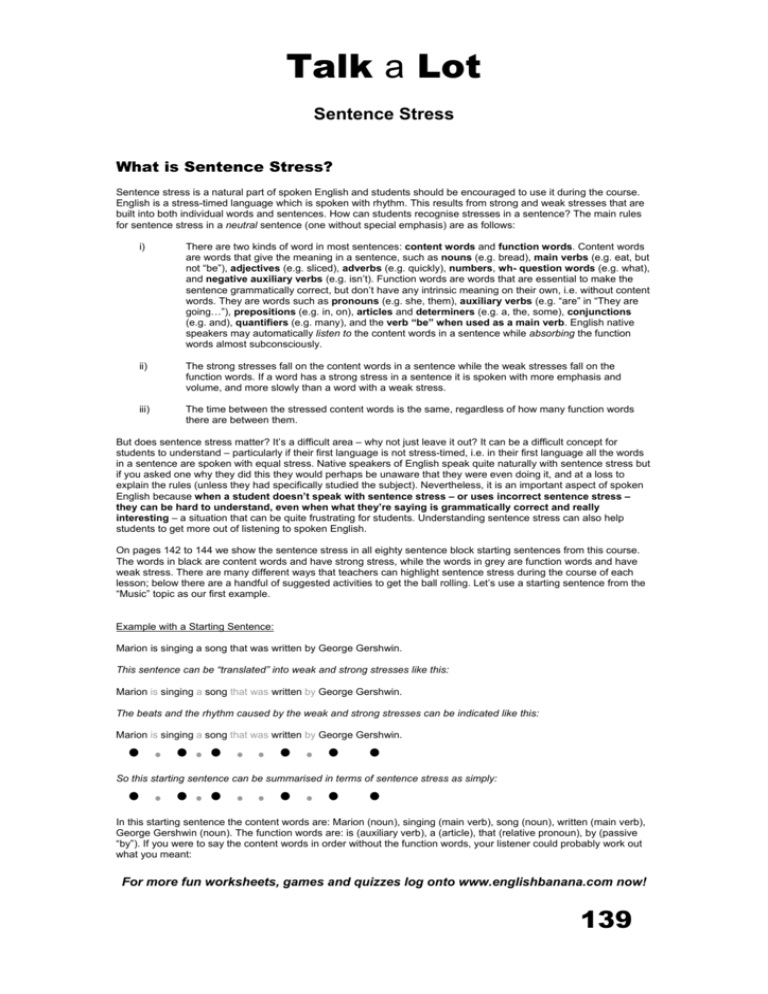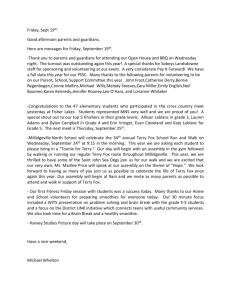Talk a Lot - English Banana
advertisement

Talk a Lot Sentence Stress What is Sentence Stress? Sentence stress is a natural part of spoken English and students should be encouraged to use it during the course. English is a stress-timed language which is spoken with rhythm. This results from strong and weak stresses that are built into both individual words and sentences. How can students recognise stresses in a sentence? The main rules for sentence stress in a neutral sentence (one without special emphasis) are as follows: i) There are two kinds of word in most sentences: content words and function words. Content words are words that give the meaning in a sentence, such as nouns (e.g. bread), main verbs (e.g. eat, but not “be”), adjectives (e.g. sliced), adverbs (e.g. quickly), numbers, wh- question words (e.g. what), and negative auxiliary verbs (e.g. isn’t). Function words are words that are essential to make the sentence grammatically correct, but don’t have any intrinsic meaning on their own, i.e. without content words. They are words such as pronouns (e.g. she, them), auxiliary verbs (e.g. “are” in “They are going…”), prepositions (e.g. in, on), articles and determiners (e.g. a, the, some), conjunctions (e.g. and), quantifiers (e.g. many), and the verb “be” when used as a main verb. English native speakers may automatically listen to the content words in a sentence while absorbing the function words almost subconsciously. ii) The strong stresses fall on the content words in a sentence while the weak stresses fall on the function words. If a word has a strong stress in a sentence it is spoken with more emphasis and volume, and more slowly than a word with a weak stress. iii) The time between the stressed content words is the same, regardless of how many function words there are between them. But does sentence stress matter? It’s a difficult area – why not just leave it out? It can be a difficult concept for students to understand – particularly if their first language is not stress-timed, i.e. in their first language all the words in a sentence are spoken with equal stress. Native speakers of English speak quite naturally with sentence stress but if you asked one why they did this they would perhaps be unaware that they were even doing it, and at a loss to explain the rules (unless they had specifically studied the subject). Nevertheless, it is an important aspect of spoken English because when a student doesn’t speak with sentence stress – or uses incorrect sentence stress – they can be hard to understand, even when what they’re saying is grammatically correct and really interesting – a situation that can be quite frustrating for students. Understanding sentence stress can also help students to get more out of listening to spoken English. On pages 142 to 144 we show the sentence stress in all eighty sentence block starting sentences from this course. The words in black are content words and have strong stress, while the words in grey are function words and have weak stress. There are many different ways that teachers can highlight sentence stress during the course of each lesson; below there are a handful of suggested activities to get the ball rolling. Let’s use a starting sentence from the “Music” topic as our first example. Example with a Starting Sentence: Marion is singing a song that was written by George Gershwin. This sentence can be “translated” into weak and strong stresses like this: Marion is singing a song that was written by George Gershwin. The beats and the rhythm caused by the weak and strong stresses can be indicated like this: Marion is singing a song that was written by George Gershwin. ● ● ● ● ● ● ● ● ● ● ● So this starting sentence can be summarised in terms of sentence stress as simply: ● ● ● ● ● ● ● ● ● ● ● In this starting sentence the content words are: Marion (noun), singing (main verb), song (noun), written (main verb), George Gershwin (noun). The function words are: is (auxiliary verb), a (article), that (relative pronoun), by (passive “by”). If you were to say the content words in order without the function words, your listener could probably work out what you meant: For more fun worksheets, games and quizzes log onto www.englishbanana.com now! 139 Talk a Lot Sentence Stress Marion is singing a song that was written by George Gershwin. Example with a Complete Sentence Block (from “The Human Body”): Terry is showing his friends the stitches in his shoulder. What The sentences can be “translated” into weak and strong stresses like this: Terry is showing his friends the stitches in his shoulder. What is Terry showing his friends? The stitches in his shoulder. Is Terry showing his friends the stitches in his shoulder? Yes, he is. Is Terry showing his friends his holiday photos? No, he isn’t. Terry isn’t showing his friends his holiday photos. The beats and the rhythm caused by the weak and strong stresses can be indicated like this: Terry is showing his friends the stitches in his shoulder. ● ● ● ● ● ● ● ● ● ● What is Terry showing his friends? ● ● ● ● ● ● …and so on. If you said only the content words, with rising intonation at the end of the yes/no questions, your listener would still get a good idea of your meaning: Terry is showing his friends the stitches in his shoulder. What is Terry showing his friends? The stitches in his shoulder. Is Terry showing his friends the stitches in his shoulder? Yes., he is. Is Terry showing his friends his holiday photos? No, he isn’t. Terry isn’t showing his friends his holiday photos. Activities for Highlighting Sentence Stress: • • • • • • • • • The teacher models the sentences and students repeat afterwards individually, in pairs, or as a group. The students mark on their handout the words in a sentence or sentence block that are content (stressed) and function (unstressed). The students record themselves saying starting sentences or sentence blocks with correct sentence stress, then listen back and check their work. The teacher (or a partner for pair work) says a starting sentence or sentence block and the listeners have to write only the content words or only the function words from it. The whole group (or pairs) have to recite sentence blocks (or individual sentences) as somebody claps, with the strong stresses falling on each clap and the weak stresses in between. The students have to form starting sentences or sentence blocks when they are given only the content words, or only the function words, and a given verb form. The students listen to songs, poems, or limericks and identify the content and function words; then practise repeating the lines with a partner or within the group. The students have to recite all the stressed words in a sentence block from memory. The students compile a list of content words and function words from a number of different sentence blocks, and put the words into groups, e.g. “noun”, “main verb”, “pronoun”, “conjunction”, “adjective”, etc. For more fun worksheets, games and quizzes log onto www.englishbanana.com now! 140 Talk a Lot Sentence Stress • • Mumbling game: the students have to say a starting sentence or sentence block, not omitting the function words completely, but mumbling them so that they are barely heard. This can demonstrate quite well how native speakers of English stress the content words – the words which have meaning – but glide over the function words as if they were of little or no importance. (Yet the function words are critically important, particularly in an English language examination situation, because they are the glue sticking the content words together.) The teacher writes the content words from one sentence on separate cards (you could use the template on page 145 of this book) and the students have to put them in order, then fill in the missing function words. A Note about Emphasis: The arrangement of weak and strong stresses in a sentence can vary according to what the speaker wishes to emphasise. Look at this example: Alan was taking a box of five hundred brown envelopes to the stockroom when he slipped on a wet floor. [Neutral – no special emphasis.] Alan was taking a box of five hundred brown envelopes to the stockroom when he slipped on a wet floor. [It is important how many brown envelopes Alan was taking.] Alan was taking a box of five hundred brown envelopes to the stockroom when he slipped on a wet floor. [It is important where Alan was taking the box of brown envelopes.] …and so on. For more fun worksheets, games and quizzes log onto www.englishbanana.com now! 141






